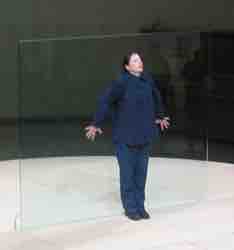Background
Conceptual art emerged as a movement during the 1960s. In part, it was a reaction against formalism as the influential New York art critic Clement Greenberg then articulated it. According to Greenberg, modern art followed a process of progressive reduction and refinement toward the goal of defining the essential, formal nature of each medium. Those elements that ran counter to this nature were to be reduced.
The task of painting, for example, was to define precisely what kind of object a painting truly is: what makes it a painting and nothing else? The nature of paintings was to be flat objects with canvas surfaces onto which colored pigment is applied. Thus, such things as figuration, 3-D perspective illusion, and references to external subject matter were all found to be extraneous to the essence of painting, so ought to be removed.
Some have argued that conceptual art continued this dematerialization of art by removing the need for objects altogether, while others, including many of the artists themselves, saw conceptual art as a radical break from Greenberg's kind of formalist modernism. Later artists continued to share a preference for self-critical art, as well as a distaste for illusion. However, by the end of the 1960s, it was certainly clear that Greenberg's stipulations for art no longer held traction.
Performance art is a performance presented to an audience, traditionally interdisciplinary. The performance may be scripted or unscripted, random or carefully orchestrated, spontaneous or otherwise carefully planned, and occur with or without audience participation. The performance can be live or via media; the performer can be present or absent. It can be any situation that involves four basic elements: time, space, the performer's body or presence in a medium, and a relationship between the performer and the audience. Performance art can happen anywhere, in any venue or setting and for any length of time. The actions of an individual or a group at a particular place and in a particular time constitute the work.

Marina Abramovic Performance Artist
Marina Abramovic - Guggenheim - Seven Easy Pieces - 1st Night
Contemporary Influence In Conceptual Art
The first wave of the conceptual art movement extended from approximately 1967 to 1978. Early concept artists like Henry Flynt, Robert Morris, and Ray Johnson influenced the later widely accepted movement of conceptual art. Conceptual artists like Dan Graham, Hans Haacke, and Lawrence Weiner have proven very influential on subsequent artists, and well-known contemporary artists such as Mike Kelley or Tracey Emin are sometimes labeled "second- or third-generation" conceptualists, or post-conceptual artists.
Contemporary artists have taken many of the concerns of the conceptual art movement up. While they may or may not identify themselves as conceptual artists, ideas such as anti-commodification, social and political critique, and ideas / information as medium continue to be aspects of contemporary art, especially among artists working with installation art, performance art, net.art, and digital art.
Visual Arts, Performing Arts, and Art Performance
Performance art is an essentially contested concept: any single definition of it implies the recognition of rival uses. As concepts like "democracy" or "art", it implies productive disagreement with itself.
The meaning of the term in the narrower sense is related to postmodernist traditions in Western culture. From about the mid-1960s into the 1970s, performance art often derived from concepts of visual art, with respect to Antonin Artaud, Dada, the Situationists, Fluxus, Installation art, and Conceptual Art. It therefore tended to be defined as the antithesis to theatre, challenging orthodox art forms and cultural norms. The ideal was an ephemeral and authentic experience for the performer and audience in an event that could not be repeated, captured, or purchased.
Performance artists often challenge the audience to think in new and unconventional ways, break conventions of traditional arts, and break down conventional ideas about "what art is. " As long as the performer does not become a player who repeats a role, performance art can include satirical elements (compare Blue Man Group); utilize robots and machines as performers, as in pieces of the Survival Research Laboratories; or borrow elements of any performing arts such as dance, music, and circus.